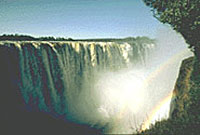Zambia

- © UNESCO
- Mosi-oa-Tunya / Victoria Falls
Zambia joined UNESCO on 9 November 1964. It is covered by the UNESCO Office in Harare, Zimbabwe.
In education, Zambia implements EDUCAIDS, for HIV/Aids prevention, and UNESCO's Teacher Training Initiative for sub-Saharan Africa (TTISSA), aimed at restructuring national policies.
The World Heritage List includes the country’s famous Mosi-oa Tunya /Victoria Falls natural site. The Gule Wamkulu ritual dance (also practiced in Mozambique and Malawi) and the Vimbuza Healing Dance were proclaimed Masterpieces of the Oral and Intangible Heritage of Humanity in 2005. Zambia also participates in the African Liberation Heritage project, preserving the memory of independence movements.
In 2007, Zambia was elected to UNESCO’s Executive board (until 2011), the Intergovernmental Council for the International Programme for the Development of Communication (IPDC), and the Intergovernmental Bioethics Committee.
The Zambian private newspaper Mining Mirror received a UNESCO grant of US$20,000 in 2007 for capacity-building.

